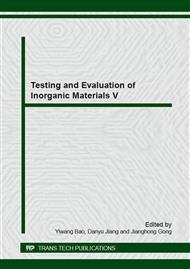p.234
p.240
p.245
p.249
p.253
p.257
p.261
p.265
p.269
Preparation and Luminescence Properties of SrMoO4 Doped with Pr3+
Abstract:
A red light-emitting phosphor of SrMoO4: Pr3+ was synthesized by a convenient high-temperature solid-state reaction method. The structures, morphologies and optical properties of as-prepared products were characterized by X-ray diffraction (XRD), transmission electron microscope (FESEM) and photoluminescent (PL). A strong red emission centered at 645 nm corresponding to the 3P0→3F2 transition of Pr3+ is observed under 430–500 nm excitated. In addition, it has been found that M+ (M+ = Li+, Na+ or K+) codoped SrMoO4: Pr3+ phosphors could lead to a remarkable increase of photoluminescence. Luminous intensity was the highest when doping Na+ ions. The influence of the sintering temperature on the luminescence properties of the phosphors is also discussed. The optimum sintering temperature was 900°C. The average particle size was about 2~4 μm. Thus, it is a promising material for solid-state lighting based on GaN light-emitting diode (LED).
Info:
Periodical:
Pages:
253-256
Citation:
Online since:
November 2014
Authors:
Price:
Сopyright:
© 2015 Trans Tech Publications Ltd. All Rights Reserved
Share:
Citation:


